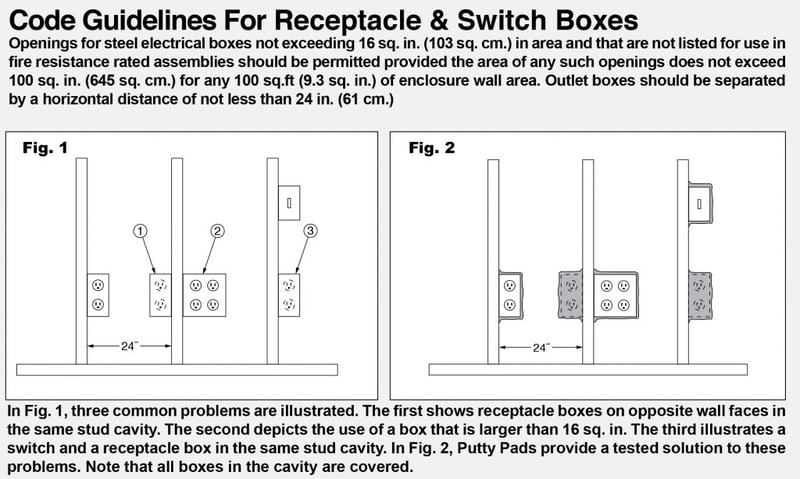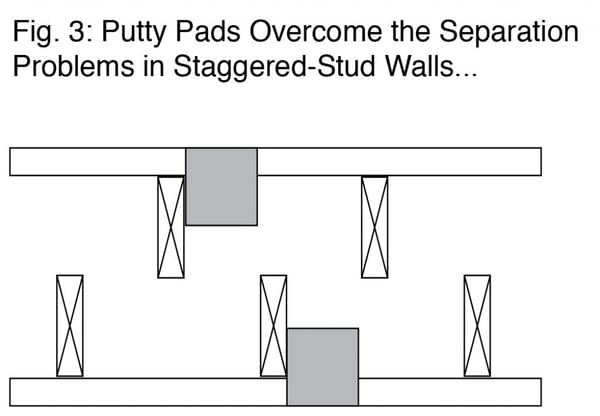Firestop Putty Pads – When, Where and How to Use Them
One of the least publicized and most misunderstood products in the SpecSeal® line would have to be our putty pads. At the request of several of our customers, we’re going to attempt to remove the shroud of mystery surrounding this product by answering some of the most commonly asked questions.
What are putty pads used for? This is really the question most people ask. Putty pads are designed to be applied to the external surfaces of metallic and nonmetallic switch and receptacle boxes in some rated wall conditions. We also have used putty pads in a few systems for through-penetrations. Let’s discuss the electrical box usage first and then cover their use in through-penetration firestops.
Where did this idea come from? Sound deadening pads historically have been used in some jurisdictions to meet noise abatement (sound attenuation) requirements between living units in apartments or condos. An inspector in southern California about a dozen years ago happened to pick one up at a job site and apply a lighter to it. The pad went up in flames. He requested that pads be made from a firestopping putty and thus an idea was born.
Why are they used? Over time, sound deadening has actually become a secondary use for putty pads. The pads are now used primarily to overcome certain restrictions on the number and placement of electrical boxes in rated gypsum wallboard assemblies.
How are they used? Putty pads, as mentioned above, are designed to be applied to the external surfaces of metallic and nonmetallic boxes. They are applied to the back surface of the box, as well as the three sides that are away from the stud.
The installation sequence is after the gypsum board is applied to one side and before it is closed in on the other side. Installing the pad on the side where the board is already installed is straight forward. Installing it on the other side requires some technique. The pad must be applied to the box and then either lapped over the front of the tile plate (if one is used) or excess material must be worked toward the front of the box and built up into a compressible gasket much like the pinched area of a pie crust. This gasket compresses between the front edge of the box and the gypsum board as the board is installed.
 When are they used? Putty pads are used in conjunction with metallic and nonmetallic electrical boxes under the following conditions:
When are they used? Putty pads are used in conjunction with metallic and nonmetallic electrical boxes under the following conditions:
1. Where the aggregate area of the boxes will exceed 100 sq. in. per 100 sq. ft. of wall. This restriction can be of particular importance in construction where the required concentrations of building services are very heavy (hospital rooms). High ceilings also can reduce the allowable amount of building services by decreasing the length of the wall required to hit the 100 sq. ft. total.
2. Where the horizontal spacing of the boxes must be less than the required 24 inches. This is a particular problem in back to back installations such as adjoining kitchens or bathrooms located on common rated walls.
3. In staggered-stud walls (See Fig. 3 above) where stud cavities are not isolated and physical separation of boxes is impractical.
4. Where the required box must be larger than the permitted 16 sq. in. Present testing includes boxes up to 22 sq. in. (4-11/16” square boxes).
Using Putty Pads… Who makes the call? Putty pads are a tested method for overcoming some of the limitations suggested by the NFPA Life Safety Code. It is important to understand that adherence to these limitations is at the discretion of the local authority having jurisdiction. Thus the use of the pads and their acceptance as a means of addressing these limitations is also at the discretion of the local authority having jurisdiction. The bottom line being… Check with your local inspector before installing this product!
What about the cost? Putty pads do add cost! The pads are often more expensive than the cost of the boxes themselves. But they are less expensive than the alternatives. Some
jurisdictions require that boxes be framed in with additional studs and gypsum board. This is particularly true in walls that utilize parallel staggered stud membranes. In these walls there is no true separation between stud cavities. Putty pads also reduce cost by allowing the designer greater freedom in designing mirror image living units along rated walls.
Putty Pads in Through-Penetration Firestops
STI utilizes putty pads in some throughpenetration firestop designs. The shape of the pad as well as some of its unique properties work perfectly in solving a number of unique problems. Consider putty pads when you encounter theh following conditions:
• Isolating copper pipes… Putty pads are highly water-resistant. By breaking the path to ground, they can help prevent galvanic corrosion.
• Allow pipe movement by wrapping penetrants with putty pads prior to pouring in firestop mortar.
• Putty pads isolate plastic pipes from concrete or mortar to help speed reaction of intumescent materials.
• Lay putty pads under and over cables in tray applications to firestop and smoke seal heavy cable bundles-this is particularly effective in pillow installation.






